Microsoft PL-600 Real Exam Questions
The questions for PL-600 were last updated at Apr 16,2025.
- Exam Code: PL-600
- Exam Name: Microsoft Power Platform Solution Architect
- Certification Provider: Microsoft
- Latest update: Apr 16,2025
You need to select an appropriate app for Relecloud.
Which app should you recommend?
- A . Dynamics 365 Field Service
- B . Dynamics 365 Sales
- C . Dynamics 365 Project Operations
- D . Dynamics 365 Customer Service
D
Explanation:
Microsoft Dynamics 365 Customer Service is a module for customer service automation that streamlines case and knowledge management, enables personalized customer service with a 360-degree customer view, and provides visibility into customer service department performance with dashboards and reports.
Reference: https://docs.microsoft.com/en-us/dynamics365/customer-service/overview
Topic 1, First Up Consulting
Case study
This is a case study. Case studies are not timed separately. You can use as much exam time as you would like to complete each case. However, there may be additional case studies and sections on this exam. You must manage your time to ensure that you are able to complete all questions included on this exam in the time provided.
To answer the questions included in a case study, you will need to reference information that is provided in the case study. Case studies might contain exhibits and other resources that provide more information about the scenario that is described in the case study. Each question is independent of the other questions in this case study.
At the end of this case study, a review screen will appear. This screen allows you to review your answers and to make changes before you move to the next section of the exam. After you begin a new section, you cannot return to this section.
To start the case study
To display the first question in this case study, click the Next button. Use the buttons in the left pane to explore the content of the case study before you answer the questions. Clicking these buttons displays information such as business requirements, existing environment, and problem statements. If the case study has an All Information tab, note that the information displayed is identical to the information displayed on the subsequent tabs. When you are ready to answer a question, click the Question button to return to the question.
Background
First Up Consulting recruits information technology (IT) workers for temporary or permanent positions at client companies. The company operates offices in multiple countries/regions.
First Up has both full-time and part-time employees. The company has a team or worker support agents that respond to inquiries from current and prospective workers. Some of the worker support agents are multilingual.
The company does not have a standardized tool used for reporting purposes. The organization engages you to implement a new Power Platform solution. Workers are managed by a dedicated team that includes one primary recruiter and a contract assistant. Many client companies live in areas that do not allow for mobile data connections.
Current environment
Existing systems and processes
– First Up uses an on-premises system to manage current and historical patient data including medications and medical visits.
– The company plans to reference historical data in the existing system. The records held in these systems will not be migrated to the new solution except for medication information.
– Employee authentication with the existing system is provided by an on-premises Active Directory instance that is linked to Azure Active Directory.
– An appointment record is created for each visit with a worker. The record includes worker contact information, preferred language, the date and time of the appointment, and other relevant data. This information is reviewed by the worker’s primary recruiter.
– First Up has no current capabilities for forecasting future worker needs based on the data held.
Client company visits
Before First Up signs a contract to place workers at a client company, a member of the audit team visits the company and interviews company management. Audit members use different types of devices including Android and iOS devices. First Up has no plans to require the use of a single type of device. Audit team members currently record information about workers on paper forms. Team members enter information from paper forms into the system when they return to the office.
First Up audits client companies at least once each year but may schedule additional visits based on feedback from workers that they place at a client company.
Requirements
General
– There is no standardized communication tool across the company, and this causes communication issues between different teams.
– First up employees must be able to contact each other by using a secure system to ask and answer questions about medical cases.
– Workers must be able to communicate in near real-time with worker support agents.
Client company visits
– Audit team records must be locked after they have been reviewed by a First Up manager. No further edits to the record can be carried out. This must be implemented using standard available system functionality.
– Audit teams must be able to enter records of their visits to the companies where they have or may place workers. Audit teams must be able to update any necessary records with the latest information.
– The solution must support tracking of security clearance information for a worker including the date, status, and certifying agency.
– When a worker makes an appointment, the appointments must appear in the timeline for the worker’s contact record.
Job history information
– The solution must provide a worker appointment booking system that can access worker historical job placement data.
– The solution must allow employees to associate a primary recruiter with each worker. The solution must also allow multiple secondary recruiters to be associated with each worker.
– Every worker assessment performed must be validated and countersigned by the primary recruiter for a worker.
– Job posting data from previous work engagements must be accessible by the Power Platform solution to ensure that new job postings are accurate.
– First Up staff members must be able to view and update worker records. They must be able to see current and historical job placement data on the same form in the new solution.
Worker access
– The solution must support workers that speak different languages. The solution must provide automatic translation capabilities.
– The solution must support near real-time communications between workers and recruiters.
– Workers must be able to view their records online. Workers must be able to enter any additional information that is required by or may be helpful to recruiters.
– The solution must provide workers a way to search for general information about available positions.
– Workers must be able to request copies of their records by using a chatbot. Workers must be able to provide information to a recruiter as needed.
Data platform
– Audit teams must have the ability to view worker information on their mobile devices.
– Audit teams must be able to record data during visits to locations where workers are placed.
– The solution must support the ability for a corporate governance auditing team to periodically audit the organization’s records, policies, and procedures.
Reporting and analytics
– The reporting and analytics team must be able to create reports that include data from all facilities and all workers.
– Management reports must present an overview of the entire organization. Other reports may be limited to specific offices.
– You must create dashboards that show the status across all groups of workers. The dashboards must be embedded into the Power Platform apps. Updates to data must be displayed in near real time.
Security
– Authentication for all user types must be managed by a single platform. IT teams must use PowerShell to apply security permissions for users.
– Worker records must only be viewed by the recruiting office that the worker visits.
– Worker still records must be archived after ten years and are then removed from the main system. Worker information must not be deleted from the system while skill and job placement history records for the worker exist in the system.
– User security roles must be customized to ensure that users are able to interact only with the specific data in which they need access.
– Workers must be able to sign into a portal by using their own email address. Workers must be required to use a secure method of authentication to be able to view their data.
– Alerts regarding the number of recruited and placed at client companies must be updated as background processes.
Issues
The organization reports the following issues:
– Recruiters report that they cannot see historical job placement data for workers.
– API usage reports show that the number of API calls made exceeds limits. This causes delays saving data.
– Users cannot view Power BI reports within the Power Platform apps.
– Some security clearance information for workers not visible from within the Power Platform solution.
– Audit teams report that they cannot view or edit worker data when the device on which they access the solution does not have network connectivity.
– The testing ream reports that one of the canvas apps is not working as expected. An error message displays as specific pages load.
DRAG DROP
You need to recommend the appropriate messaging channel solutions for the organization.
What should you recommend? To answer, drag the appropriate messaging options to the correct user types. Each messaging option may be used once, more than once, or not at all. You may need to drag the split bar between panes or scroll to view content. NOTE: Each correct selection is worth one point.


Explanation:
Box 1: Omnichannel for Customer Service dashboard
Scenario: Workers must be able to communicate in near real-time with worker support agents. The company has a team or worker support agents that respond to inquiries from current and prospective workers. Some of the worker support agents are multilingual.
If you choose to expand your customer service offering to provide chat and channels, the Customer Service workspace seamlessly adjusts to support managing conversations as well.
Note: As an agent with the Customer Service Representative security role, when you open Customer Service workspace, you start on the Customer Service Agent Dashboard unless your administrator has changed the default view. This dashboard shows you your active cases, cases you can work in queues you are assigned to, and your open activities. You can open existing cases and activities or begin working new cases from the queues you are assigned to and create activities.
Box 2: Dynamics 365 Customer Service
Scenario: First Up uses an on-premises system to manage current and historical patient data including medications and medical visits.
Reference: https://docs.microsoft.com/en-us/dynamics365/customer-service/csw-overview
Topic 4, Misc. Questions
A company uses two separate unlinked apps to manage sales leads: a Power Apps app and a third-party application.
The client has the following requirements:
✑ Manage all leads by using the Power Apps app.
✑ Create a lead in the Power Apps app when a user creates a lead in the third-party application.
✑ Update leads in the Power Apps app when a user updates a lead in the third-party application.
✑ Connect to the third-party application by using an API.
You need to recommend strategies to integrate the Power Apps app and the third-party application.
Which three options can you use to achieve the goal? Each correct answer presents part of the solution. NOTE: Each correct selection is worth one point.
- A . Dual-write
- B . Custom connector
- C . Dataflow
- D . Power Automate cloud flow
- E . DataService connector
ADE
Explanation:
A: Customers should be able to adopt business applications from Microsoft and expect they speak the same language and seamlessly work together. Dual Write allows our customers to not think about these apps as different systems to write to independently; rather, the underlying infrastructure makes it seamless for these apps to write simultaneously.
D: Use Custom APIs to create your own APIs in Dataverse. With a Custom API you can consolidate a group of operations into an API that you and other developers can call in their code. The Common Data Service (current environment) connector enables calling Custom APIs actions in Power Automate.
E: Common Data Service provides access to the environment database on the Microsoft Common Data Service. It is available for Logic Apps, Power Automate, and Power Apps.
Reference:
https://docs.microsoft.com/en-us/business-applications-release-notes/april19/cdm-data-integration/dual-writelink-common-data-service-apps
https://docs.microsoft.com/en-us/connectors/commondataservice/
https://docs.microsoft.com/en-us/powerapps/developer/data-platform/custom-api
HOTSPOT
You need to ensure that the solution meets the data security and compliance requirements.
What should you recommend? To answer, select the appropriate options in the answer area. NOTE: Each correct selection is worth one point.
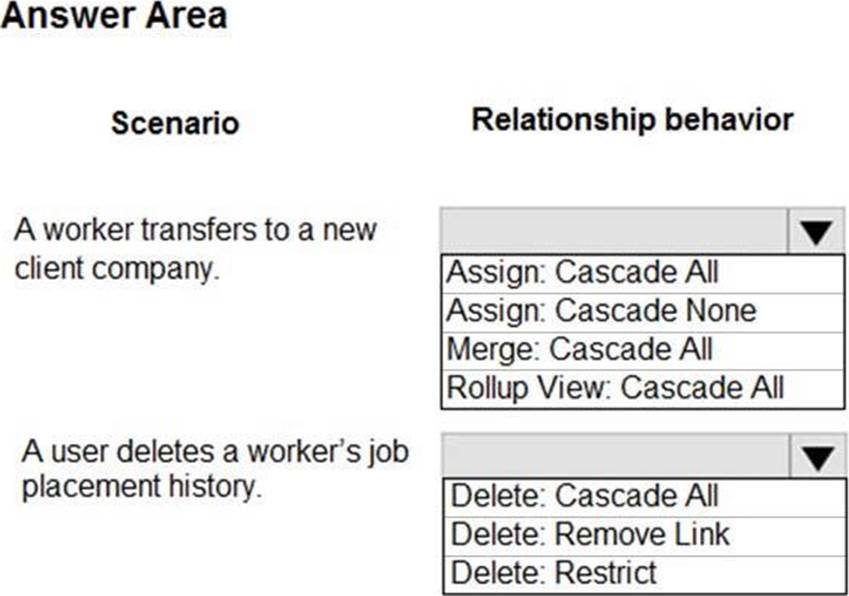
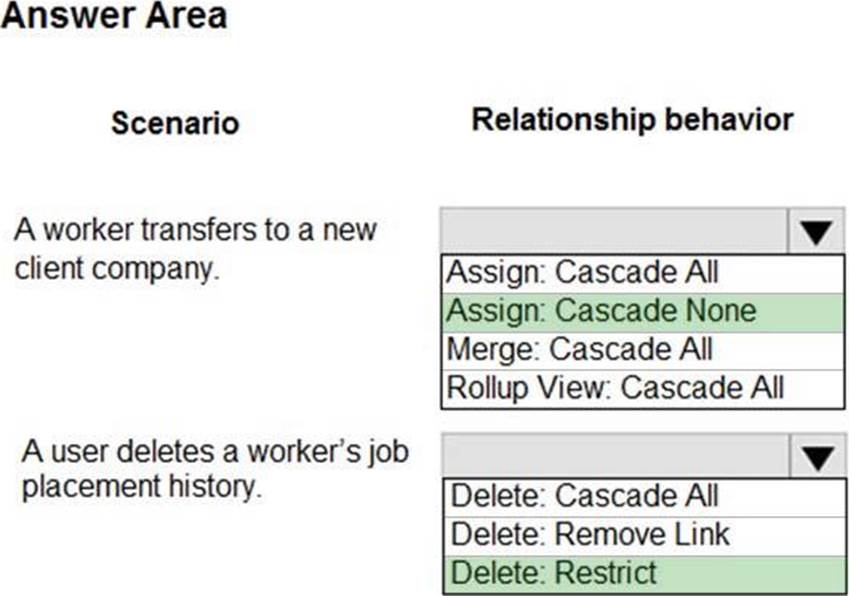
Explanation:
Box 1: Assign: Cascade None
Scenario: Worker still records must be archived after ten years and are then removed from the main system.
Assign: The referenced table record owner is changed.
Cascade None: Do nothing.
Incorrect Answers:
Cascade All: Perform the action on all referencing table records associated with the referenced table record.
Box 2: Delete: Restrict
Scenario: Worker information must not be deleted from the system while skill and job placement history records for the worker exist in the system.
Referential, Restrict Delete: In a referential, restrict delete relationship between two tables, you can navigate to any related rows. Actions taken on the parent row will not be applied to the child row, but the parent row cannot be deleted while the child row exists. This is useful if you do not want child rows to become orphaned. This forces the user to delete all of the children before deleting the parent.
Reference: https://docs.microsoft.com/en-us/powerapps/maker/data-platform/data-platform-entity-lookup
HOTSPOT
You need to recommend a solution to meet user interface requirements.
What should you recommend? To answer, select the appropriate options in the answer area. NOTE: Each correct selection is worth one point.
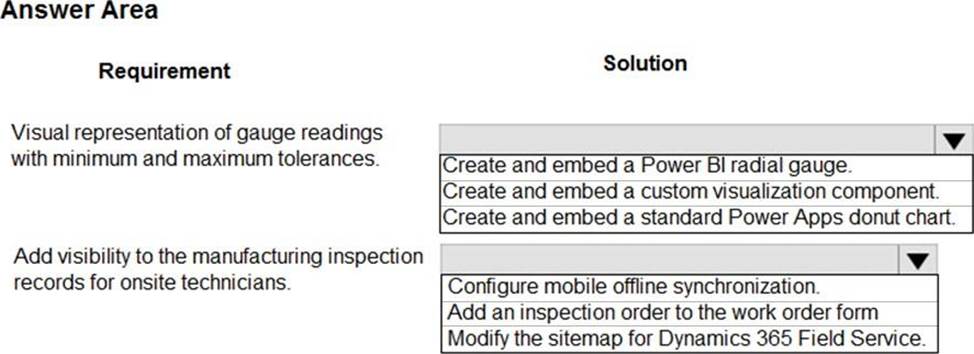
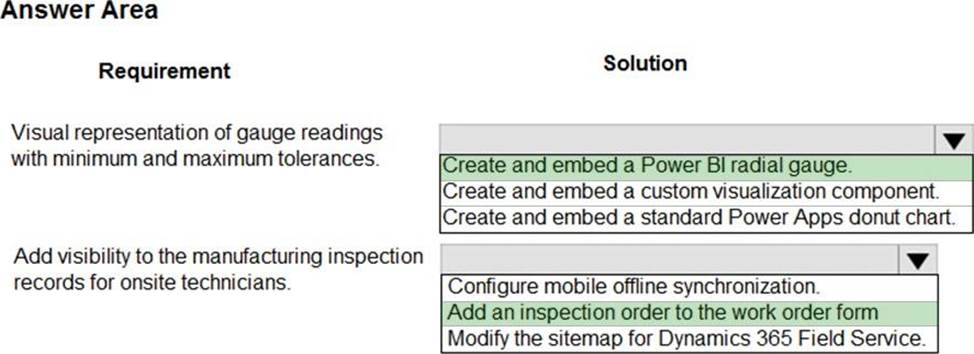
Explanation:
Box 1: Create and embed a Power Bi radial gauge
A radial gauge chart has a circular arc and shows a single value that measures progress toward a goal or a Key Performance Indicator (KPI). The line (or needle) represents the goal or target value. The shading represents the progress toward that goal. The value inside the arc represents the progress value. Power BI spreads all possible values evenly along the arc, from the minimum (left-most value) to the maximum (right-most value).
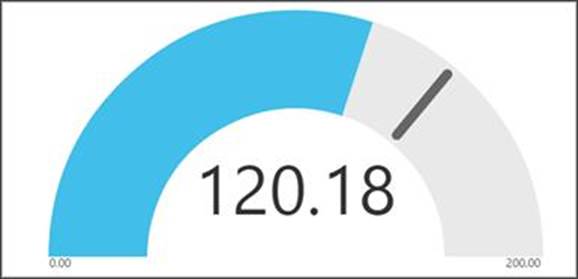
In this example, you’re a car retailer tracking the sales team’s average sales per month. The needle represents a 140 cars sales goal. The minimum possible average sales is 0 and the maximum is 200. The blue shading shows that the team is averaging approximately 120 sales this month.
Box 2: Add an inspection order to the work order form
You can add inspections to work orders in Dynamics 365 Field Service.
Field Service inspections are digital forms that technicians use to quickly and easily answer a list of questions as part of a work order. The list of questions can include safety protocols, pass-and-fail tests for a customer asset, an interview with a customer, or other audits and assessments performed before, during, or after a work order.
Example:
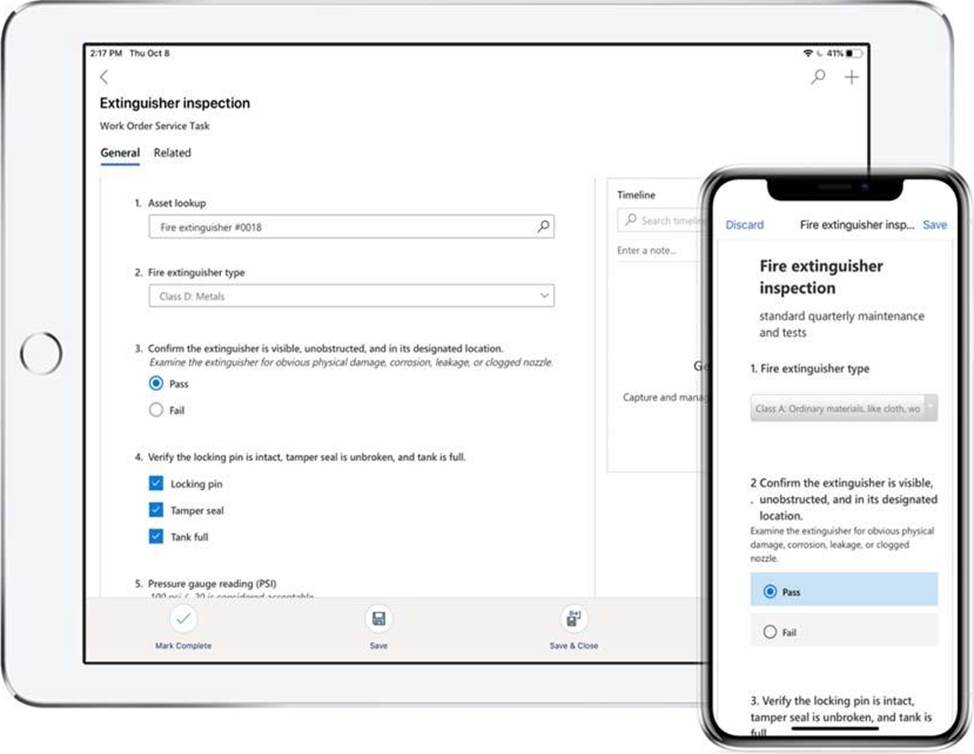
Reference:
https://docs.microsoft.com/en-us/power-bi/visuals/power-bi-visualization-radial-gauge-charts
https://docs.microsoft.com/en-us/dynamics365/field-service/inspections
You need to resolve the issue reported during testing.
What should you do?
- A . Create an image data type within the Inspection Order table.
- B . Create a relationship within the Inspection Order table to the originating inspection order.
- C . Create a Quick View form for the inspection order.
A
Explanation:
Need to store the image in the table.
Scenario: The company uses photos of employees to generate employee badges. Photos are uploaded into Microsoft 365 user profiles.
You are a Power Platform consultant for an internet support company.
The company lacks a budget to buy third-party ISVs or add-ons.
The company requires a new system that achieves the following:
✑ All support issues must come in by email, need to be logged, and assigned to the support group.
✑ Accounts must synchronize with the parent company Oracle database.
✑ Reports must be sent to the executives on a weekly basis.
✑ No custom code will be used in the system.
You need to recommend the components that should be configured.
Which two components should you recommend? Each correct answer presents part of the solution. NOTE: Each correct selection is worth one point.
- A . Power Virtual Agents
- B . Microsoft Dataverse
- C . server-side synchronization
- D . Microsoft Customer Voice
BD
Explanation:
The Dynamics 365 Customer Voice data is stored in Microsoft Dataverse.
Dynamics 365 Customer Voice is an enterprise feedback management application you can use to easily keep track of the customer metrics that matter the most to your business. … It provides a personalized experience, enabling you to collect customer feedback and get relevant insights quickly and easily, all in a few clicks.
Reference:
https://docs.microsoft.com/en-us/dynamics365/customer-voice/about
https://docs.microsoft.com/en-us/dynamics365/customer-voice/data-flow
You need to provide the IT specialists with design diagrams.
What should you provide?
- A . Business process modeler (BPM) B Al Builder
- B . Entity relationship diagram (ERD)
- C . Dynamics 365 Product Visualize
A
Explanation:
Scenario: IT specialists want to design Power BI reports. They need to understand the underlying table relationships of the system.
Business process modeler (BPM) in Microsoft Dynamics Lifecycle Services (LCS) is a tool that you can use to create, view, and modify repeatable implementations that are based on business process libraries. BPM helps you align your business processes with industry-standard processes that are described by the American Productivity & Quality Center (APQC)
Reference: https://docs.microsoft.com/en-us/dynamics365/fin-ops-core/dev-itpro/lifecycle-services/bpm-overview
